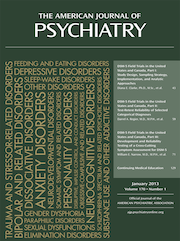In This Issue

A minority of patients in the DSM-5 Field Trials had just one diagnosis (Regier et al., p. Original article: 59)
DSM-5 Field Trials
Three articles detail the process and results of reliability tests for proposed DSM-5 diagnoses and cross-diagnosis symptom domains (figure). Clinicians of varied disciplines interviewed 2,243 patients at 11 academic medical centers. Clarke et al. (p. Original article: 43) describe the study design. Each patient was interviewed at different times by two interviewers with training comparable to what would be available in actual practice. Regier et al. (p. Original article: 59) report that of 15 adult diagnoses, 10 had very good or good test-retest reliability. Of eight diagnoses tested in children and adolescents, four had very good or good reliability. A tool new to DSM is a symptom questionnaire completed by the patient before the diagnostic interview. Narrow et al. (p. Original article: 71) found that the reliabilities for the symptom items were generally good to excellent for adults and parent-reported child symptoms. In an editorial, Freedman et al. (p. Original article: 1) highlight the good reliability of borderline personality disorder and relate the questionable reliability of major depressive disorder to its heterogeneity.
Personalized treatment of bipolar I or II disorder that includes lithium does not appear to be superior to individualized care using other evidence-based treatments. The overall remission rate was 27% in the 6-month comparison by Nierenberg et al. (p. Original article: 102), with no difference in remission or adverse events between the lithium and nonlithium groups. Outcomes for lithium may be better with higher blood levels, as the average lithium blood level in this trial was below the therapeutic range. Lithium treatment does decrease use of second-generation antipsychotics. The editorial by Dunlop et al. (p. Original article: 9) draws attention to an ecologically important outcome measure, the number of “necessary clinical adjustments.”
An emerging approach to treating comorbid mood and substance use disorders is simultaneous pharmacologic treatment of each. Patients with both types of disorders often have severe illness that is more difficult to manage than either one alone. Treatment for the mood disorder often improves mood symptoms but not alcohol or drug use. Pettinati et al. (p. Original article: 23) point to FDA-approved medications specifically for alcohol and opiate dependence. Their previous study of sertraline plus naltrexone, in addition to cognitive-behavioral therapy, showed greater effects on both depression and alcohol use from the combined medications than from either alone (Am J Psychiatry 2010; 167:668). Co-occurring bipolar and substance use disorders are difficult to treat; adding a medication for the substance disorder to a bipolar disorder treatment does not consistently decrease use. However, treating the substance use disorder is especially indicated for patients with an early onset of bipolar disorder.
Awarding a chance to receive a prize in return for each stimulant-free urine sample reduces stimulant use in outpatients with serious mental illness and stimulant dependence. In a 3-month study of 176 patients with amphetamine, methamphetamine, or cocaine dependence, McDonell et al. (CME, p. Original article: 94) calculated the cost of urine testing and reinforcers to be $864 for each participant abstinent for 8 or more weeks, but the patients had only 14 total days of hospitalization, compared to 152 days for patients in a control condition. Stimulant abstinence is associated with improvements in additional outcomes, such as alcohol use, use of injected drugs, and psychiatric symptoms. Abstinence may persist for several months after the intervention ends. Editorialist Weiss (p. Original article: 6) applauds the integration of addiction treatment and psychiatry and emphasizes the potential financial advantage for payers, such as the Veterans Health Administration, which recently approved contingency management for drug dependence.



